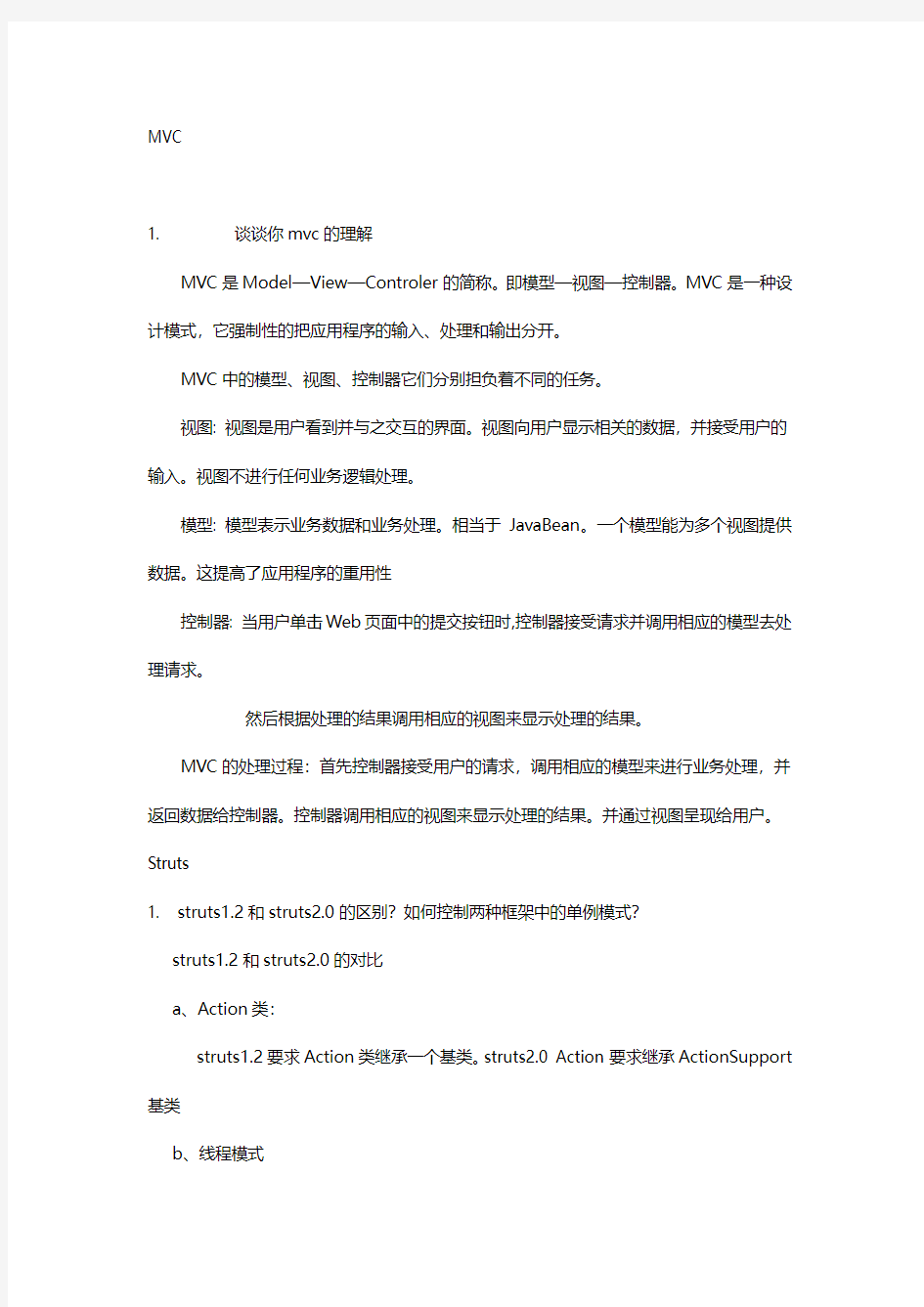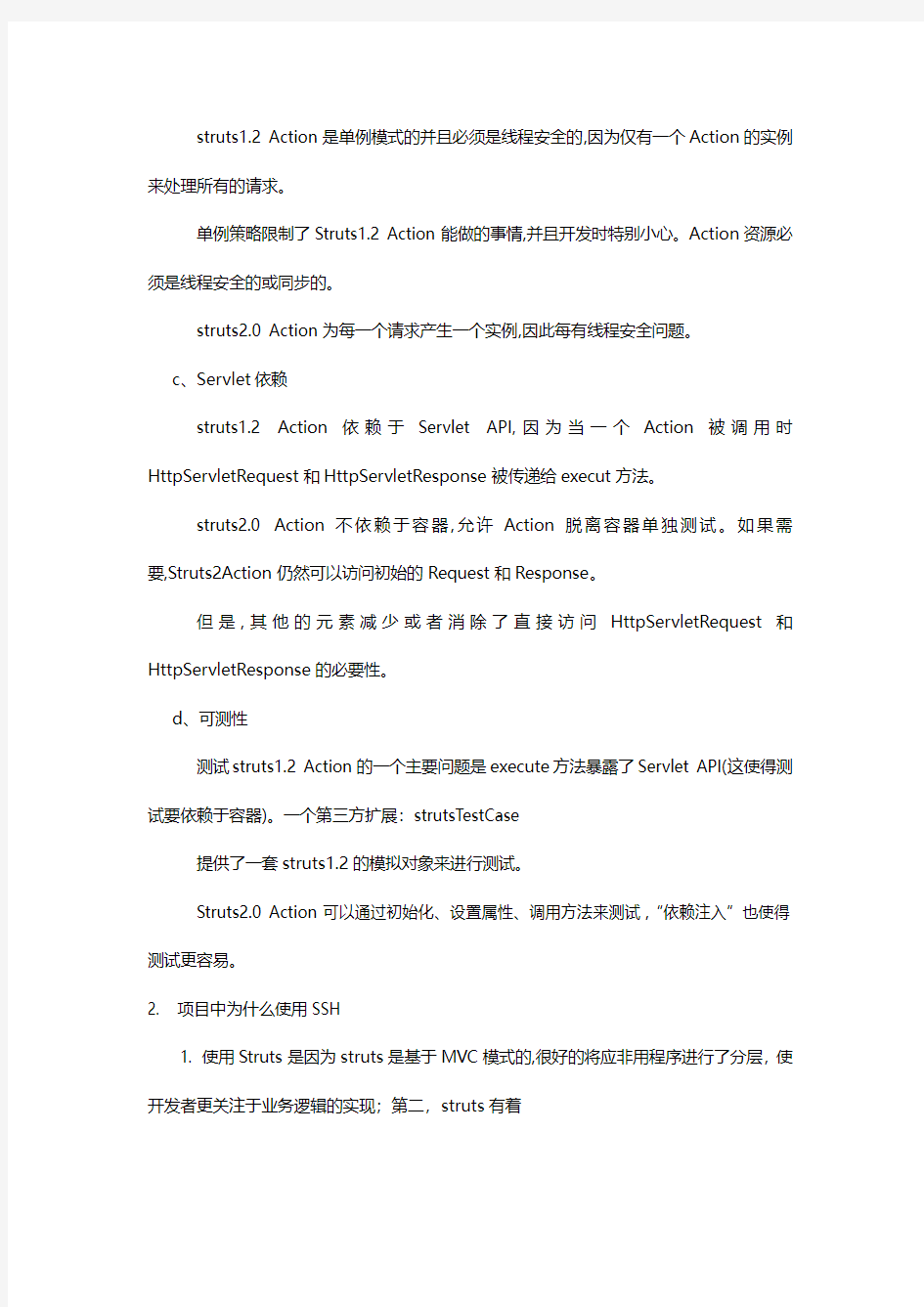JavaEE常见面试题


MVC
1. 谈谈你mvc的理解
MVC是Model—View—Controler的简称。即模型—视图—控制器。MVC是一种设计模式,它强制性的把应用程序的输入、处理和输出分开。
MVC中的模型、视图、控制器它们分别担负着不同的任务。
视图: 视图是用户看到并与之交互的界面。视图向用户显示相关的数据,并接受用户的输入。视图不进行任何业务逻辑处理。
模型: 模型表示业务数据和业务处理。相当于JavaBean。一个模型能为多个视图提供数据。这提高了应用程序的重用性
控制器: 当用户单击Web页面中的提交按钮时,控制器接受请求并调用相应的模型去处理请求。
然后根据处理的结果调用相应的视图来显示处理的结果。
MVC的处理过程:首先控制器接受用户的请求,调用相应的模型来进行业务处理,并返回数据给控制器。控制器调用相应的视图来显示处理的结果。并通过视图呈现给用户。Struts
1. struts1.2和struts
2.0的区别?如何控制两种框架中的单例模式?
struts1.2和struts2.0的对比
a、Action类:
struts1.2要求Action类继承一个基类。struts2.0 Action要求继承ActionSupport 基类
b、线程模式
struts1.2 Action是单例模式的并且必须是线程安全的,因为仅有一个Action的实例来处理所有的请求。
单例策略限制了Struts1.2 Action能做的事情,并且开发时特别小心。Action资源必须是线程安全的或同步的。
struts2.0 Action为每一个请求产生一个实例,因此每有线程安全问题。
c、Servlet依赖
struts1.2 Action依赖于Servlet API,因为当一个Action被调用时HttpServletRequest和HttpServletResponse被传递给execut方法。
struts2.0 Action不依赖于容器,允许Action脱离容器单独测试。如果需要,Struts2Action仍然可以访问初始的Request和Response。
但是,其他的元素减少或者消除了直接访问HttpServletRequest和HttpServletResponse的必要性。
d、可测性
测试struts1.2 Action的一个主要问题是execute方法暴露了Servlet API(这使得测试要依赖于容器)。一个第三方扩展:strutsTestCase
提供了一套struts1.2的模拟对象来进行测试。
Struts2.0 Action可以通过初始化、设置属性、调用方法来测试,“依赖注入”也使得测试更容易。
2. 项目中为什么使用SSH
1. 使用Struts是因为struts是基于MVC模式的,很好的将应非用程序进行了分层,使开发者更关注于业务逻辑的实现;第二,struts有着
丰富的taglib,如能灵活运用,则能大大提高开发效率。
2. 使用Hibernate:因为hibernate为Java应用提供了一个易用的、高效率的对象关系映射框架。hibernate是个轻量级的持久性框架,功能丰富。
3. 使用Spring:因为spring基于IoC(Inversion of Control,反向控制)和AOP构架多层j2ee系统的框架,但它不强迫你必须在每一层
中必须使用Spring,因为它模块化的很好,允许你根据自己的需要选择使用它的某一个模块;
采用IoC使得可以很容易的实现bean的装配,提供了简洁的AOP并据此实现事务管理(Transcation Managment),等等
3. struts与spring是如何继承的
不懂题目之意:是否是说的struts的action都继承自org.apache.struts.action.Action 而Spring中的继承就不清楚了。
4. struts如何实现国际化
以下以两国语言(中文,英文)为例:
1. 在工程中加入Struts支持
2. 编辑ApplicationResource.properties文件,在其中加入要使用国际化的信息, 例如:lable.welcome.china=Welcome!!!
3. 创建英文资源文件ApplicationResource_en.properites
4. 创建临时中文资源文件ApplicationResource_temp.properites 例如:lable.welcom.china=中国欢迎您!
5. 对临时中文资源文件进行编码转换。可以使用myeclipse的插件,也可以在dos下执行:
native2ascii -encoding gb2312ApplicationResource_temp.properties ApplicationResource_zh_CN.properties
6. 在jsp中加入struts的bean标记库<%@ tagliburi="/WEB-INF/struts-bean.tld" prefix="bean"%>
显示信息:
可以在struts-config.xml文件中定义多个资源包,而每个资源包可使用key属性指定包的名称。
5. struts2.0的常用标签
1. 往action里传值:
2. 显示标签property 用于输出指定值:
3. 用于从页面往action中(user)的对象内传值:
4. 判断
5. 迭代
6. URL地址标签,
7. 超链接一般和
">超链接
8. set标签,用于将某个值放入指定的范围内。例如application,session等。
6. struts中怎么配置form-bean、action、tiles
此处配置的是struts1.2的
form-bean配置:(在配置文件struts-config.xml中):
name: 指定form的名字; type指定form的类型:包名+类名;
action配置:(在配置文件struts-config.xml中)
attribute="" input="" name="" parameter="" scope="request" type="" > path:请求Action的名字; attribute:form的名字,与form-bean中的name对应; input:输入页的路径; name:如果配置了attribute,name不起作用,与attribute一样; parameter:使用分发Action时,指定调用分发Action中的方法名; scope:Action的范围; type:Action的类型:包名+类名; tites配置: 1. 新建一个tiles-defs.xml文件,并在其中做如下配置: 2. 在web.xml和struts-config.xml和web.xml中做相应配置: 在struts-config.xml中配置如下: ************ ************ 在web.xml中配置如下: ************ ************* 3. 调用Tiles组件 Tiles组件是通过Struts Action来调用的,在struts-config.xml中做如下action 配置: ************* path="/member" parameter="member-definition" type="org.apache.struts.actions.ForwardAction"/> ************** 7. logic标签有哪几个? 此标签库可以分为三种类型:条件、循环、转发/重定向。 1. 条件类型(没标注的都比较简单) logic:empty, logic:notEmpty; logic:equal, logic:notEqual,logic:lessThan, logic:greaterThan,logic:lessEqual, logic:greaterEqual; logic:present, logic:notPresent; logic:match, logic:notMatch; 比较两字符串是否相等,可以比较字符串的开始的、结尾的或其中的某个部分。location属性:指定从某个位置开始进行比较。 2. 循环类型 logic:iterate 3. 转发/重定向类型 logic:forward和logic:redirect logic:forward标签和jsp:forward标签相似,但它可以使用globalforward中的一个ActionForward 例如: ------------------------------------------------------------------------------ 与上面相关的global forward中的代码: logic:redirect标签和上面的标签类似,但它默认调用的方法是response.sendRedirect(), 取代了上面的requestDispatcher.forward()。最大的不同是它支持所有html:link 标签的属性,所以你能够指定request参数: paramId="employeeId"paramName="employee" property="id" /> 在MVC框架下,不推荐使用这两个标签,你应该是从controller中选择下一个view,而不是从view中选择.在Jsp页面中不要过多的使用logic标签。 8. action是单实例还是多实例,为什么? action是单实例的。当多个用户访问一个请求的时候,服务器内存中只有一个与之对应的action类对象。 因为当服务器第一次加载struts的配置文件的时候,创建了一个Action后,每发送一个请求,服务器都会先去检索相应的范围内(request,session)是否存在 这样一个action实例,如果存在,则使用这个实例,如果不存在,则创建一个action实例。 9. dispatchAction是用什么技术实现的? DispatchAction 是Aciton的一个子类,主要解决了一个请求处理多个功能的问题普通的Action你只能写execute方法来处理业务,而想用这一个Action处理多个任务,你必须要请求参数进行解析,用if语句块来处理 举一个小例子: 有如下一个url: http://localhost:8080/myApp/addUserAction.do 如果你处理这个url的是一个普通的Action,那么就只能在execute里面执行插入的相关操作,如果换成一下url: http://localhost:8080/myApp/UserAction.do?method=add 你就应该根据method对象的值来执行相应的操作,如再有一个路径http://localhost:8080/myApp/UserAction.do?method=delete 这个还可以使用那个Action来处理的,只是多判断一下而已. 如果你用DispatchAction,就简单多了,所以dispatchAction还是用的Action的这么一个技术。 10. struts2.0的mvc模式?与struts1.0的区别? struts2的mvc模式:当用户在页面提交用户请求时,该请求需要提交给struts2的控制器处理。struts2的控制器根据处理结果, 决定将哪个页面呈现给客户端。 与struts1最大的不同是:struts2的控制器。struts2的控制器不再像struts1的控制器,需要继承一个Action父类,甚至可以无需实现 任何接口,struts2的Action就是一个普通的POJO。实际上,Struts2 的Action就是一个包含execute方法的普通Java类 该类里包含的多个属性用于封装用户的请求参数。 11. STRUTS的配置文件是什么? struts-config.xml 12. 请写出Struts的工作原理。 13. struts的处理流程。 一、ActionServlet的初始化 ActionServlet作为Struts组件的前端控制器,由于web.xml的相应配置: 在应用一加载时即会被实例化并调用其init方法,init方法所做的主要工作有二: 1. 加载struts配置文件,并创建用于封装配置信息的ModuleConfig对象 2. 加载资源文件,并创建用于封装资源文件的MessageResources对象 需要注意两点:如果web.xml有多模块配置,将创建多个ModuleConfig对象和MessageResources对象分别 用于封装各个模块的struts配置文件和资源文件。 针对各个模块所创建的ModuleConfig对象和MessageResources对象将存储在ServletContext中,对应的属 性名中有该模块名称的相应标识。 另外,如果有相应配置的话,init方法还将初始化数据源和PlugIn 二、ActionServlet的process 所有形如*.do的请求(根据web.xml中的相关配置)将提交给ActionServlet,最终将调用其process方法 。process方法的主要工作有三: 1. 根据请求信息获知所请求的模块名称,从ServletContext中获得与请求模块对应的的ModuleConfig对象,并存储到request中。 2. 根据模块信息获得相应的RequestProcessor对象,一个模块对应一个RequestProcessor对象,RequestProcessor对象将关联与所属模块对应的ModuleConfig对象。 3. 调用RequestProcessor对象的process方法,将request和response作为参数传递给它。 三、RequestProcessor的process RequestProcessor对象的process方法的主要工作有五步: 1. 调用自己的processPreprocess(request, response)方法,该方法不进行任何操作,用于子类重写 扩展其功能。 2. 获得与请求地址所匹配的ActionMapping对象,AcionMapping对象用于封装一个特定acion的配置信息。 3. 根据ActionMapping中的配置信息获得ActionForm对象(该对象将缓存到request 或session中),并将表单数据填充到ActionForm中,然后根据ActionMapping的配置决定是否验证ActionForm,如果验证,将调用ActionForm的validate方法,若其返回的ActionErros对象中包含ActionMessage对象则表示验证失败,将转向action配置信息input属性所指示的地址。 4. 如果ActionForm无需验证或验证通过将创建并缓存与请求地址匹配的Action对象,将ActionMapping对象、ActionForm对象、request和response作为参数调用其execute 方法。 5. 根据Action对象的execute方法返回的ActionForward对象,将请求转发或重定向到该ActionForward所封装的地址。 14. 用struts +hibernate做一个增删查改(机试) 15. Struts2.0与Struts1.x有何区别。 Feature特征 Struts 1 Struts的一 Struts 2 Struts的2 Action classes行动班 Struts 1 requires Action classes to extend an abstract base class. Struts的一要求采取行动班,以延长一个抽象的基类。A common problem in Struts 1 is programming to abstract classes instead of interfaces.一个共同的问题在Struts的一,是编程抽象类而不是接口。 An Struts 2 Action may implement an Action interface, along with other interfaces to enable optional and custom services. 1 2 Struts的行动,可能实施一项行动的界面,随着其他接口,使可选和定制服务。Struts 2 provides a base ActionSupport class to implement commonly used interfaces. Struts的2提供了相应的actionsupport一流的执行常用的接口。Albeit, the Action interface is not required.虽然,这项行动的界面是不是必需的。Any POJO object with a execute signature can be used as an Struts 2 Action object.任何波霍对象与执行的签名可以被用来作为一个Struts的二行动的对象。Threading Model线程模型 Struts 1 Actions are singletons and must be thread-safe since there will only be one instance of a class to handle all requests for that Action. Struts的一行动是单身,必须线程安全的,因为将只有一个实例一类来处理所有的请求采取行动。The singleton strategy places restrictions on what can be done with Struts 1 Actions and requires extra care to develop.单身人士策略地方的限制,可以做些什么与Struts的一行动,并要求加倍小心发展。Action resources must be thread-safe or synchronized.行动的资源,必须线程安全的或同步。 Struts 2 Action objects are instantiated for each request, so there are no thread-safety issues. 2 Struts的行动对象是实例对于每个请求,因此没有线程安全问题。 (In practice, servlet containers generate many throw-away objects per request, and one more object does not impose a performance penalty or impact garbage collection.) (在实践中,Servlet的容器,产生许多扔离家出走的对象,每次请求,并多一个对象不施加表现罚款,或影响垃圾收集)。 Servlet Dependency Servlet的依赖 Struts 1 Actions have dependencies on the servlet API since the HttpServletRequest and HttpServletResponse is passed to the execute method when an Action is invoked. Struts的一行动,依赖于该Servlet的空气污染指数以来,httpservletrequest 和httpservletresponse传递给Execute方法,当一个行动是引用。 Struts 2 Actions are not coupled to a container. Struts的行动,二是不耦合的一个货柜。Most often the servlet contexts are represented as simple Maps, allowing Actions to be tested in isolation.最经常的Servlet的背景是派代表作为简单的地图,让行动,以测试陷入孤立的境地。Struts 2 Actions can still access the original request and response, if required. 2 Struts的行动仍然可以使用原来的请求和响应,如果需要。However, other architectural elements reduce or eliminate the need to access the HttpServetRequest or HttpServletResponse directly.不过,其他建筑元素,减少或消除需要访问httpservetrequest或httpservletresponse直接。 Testability测试 A major hurdle to testing Struts 1 Actions is that the execute method exposes the Servlet API.一个主要障碍,以测试Struts的一行动是Execute方法暴露了Servlet的空气污染指数。A third-party extension, Struts TestCase, offers a set of mock object for Struts 1.第三党的扩展,Struts的testcase ,提供了一套模拟对象的Struts 1 。 Struts 2 Actions can be tested by instantiating the Action, setting properties, and invoking methods. 2 Struts的行动可以测试实例化的行动,设置属性,引用的方法。Dependency Injection support also makes testing simpler.依赖注入的支持也使测试更简单。 Harvesting Input收获的投入 Struts 1 uses an ActionForm object to capture input. Struts的一使用actionform对象捕获输入。Like Actions, all ActionForms must extend a base class.一样的行动,所有actionforms必须扩大基地,一流的。Since other JavaBeans cannot be used as ActionForms, developers often create redundant classes to capture input.由于其他的JavaBeans不能被用来作为actionforms ,开发商常常造成多余的班,以捕捉的投入。DynaBeans can used as an alternative to creating conventional ActionForm classes, but, here too, developers may be redescribing existing JavaBeans. dynabeans可以用来作为一种替代创造常规actionform班,但这里太,发展商可能会redescribing现有的JavaBeans 。 Struts 2 uses Action properties as input properties, eliminating the need for a second input object. Struts的2使用性能的行动作为输入属性,不再需要第二个输入对象。Input properties may be rich object types which may have their own properties.输入属性可能是丰富的对象类型可能有自己的属性。The Action properties can be accessed from the web page via the taglibs.行动性质可以从网页上通过taglibs 。Struts 2 also supports the ActionForm pattern, as well as POJO form objects and POJO Actions. Struts的2还支持actionform模式,以及波霍形式,对象和波霍行动。Rich object types, including business or domain objects, can be used as input/output objects.丰富的对象类型,其中包括商业利益或域对象,可以被用来作为输入/输出对象。The ModelDriven feature simplifies taglb references to POJO input objects.该modeldriven功能简化taglb的提述,波霍投入对象。 Expression Language语言表达 Struts 1 integrates with JSTL, so it uses the JSTL EL. Struts的一整合与jstl ,所以它使用jstl下午。The EL has basic object graph traversal, but relatively weak collection and indexed property support.的El已基本对象图遍历,但相对薄弱的收集和索引财产的支持。 Struts 2 can use JSTL, but the framework also supports a more powerful and flexible expression language called "Object Graph Notation Language" (OGNL). Struts的二可以使用jstl ,但框架也支持一个更强大和灵活的语言表达所谓的“对象图形符号语言”(ognl )。 Binding values into views有约束力的价值观纳入意见 Struts 1 uses the standard JSP mechanism for binding objects into the page context for access. Struts的一使用标准的JSP机制,有约束力的物体进入该网页的背景下访问。Struts 2 uses a "ValueStack" technology so that the taglibs can access values without coupling your view to the object type it is rendering. Struts的2使用“valuestack ”技术,使该taglibs可以访问的价值观没有耦合您的看法,以对象类型,这是渲染。The ValueStack strategy allows reuse of views across a range of types which may have the same property name but different property types.该valuestack 策略允许重用的意见覆盖的类型可能有相同的属性名称,但不同的属性类型。 Type Conversion类型转换 Struts 1 ActionForm properties are usually all Strings. Struts的一actionform属性通常是所有字符串。Struts 1 uses Commons-Beanutils for type conversion. Struts的一用途的商品- beanutils为类型转换。Converters are per-class, and not configurable per instance.转换器每级的,而不是配置的每个实例。 Struts 2 uses OGNL for type conversion. Struts的2使用ognl为类型转换。The framework includes converters for basic and common object types and primitives.该框架包括转换为基本和共同的对象类型和原始。 Validation验证 Struts 1 supports manual validation via a validate method on the ActionForm, or through an extension to the Commons Validator. Struts的一支持手册审定通过验证方法对actionform ,或通过一个扩展到商品校验。Classes can have different validation contexts for the same class, but cannot chain to validations on sub-objects.班级可以有不同的验证背景为同一阶层,但不能链,以验证就分对象。 Struts 2 supports manual validation via the validate method and the XWork Validation framework. Struts的2支持手册审定通过验证的方法和xwork的验证框架。The Xwork Validation Framework supports chaining validation into sub-properties using the validations defined for the properties class type and the validation context.该xwork的验证框架支持链接验证分为分性能的使用验证的定义为性能一流的类型和验证。 Control Of Action Execution控制行动的执行 Struts 1 supports separate Request Processors (lifecycles) for each module, but all the Actions in the module must share the same lifecycle. Struts的一支持独立的请求处理器(生命周期)为每个单元,但所有的行动,在该模块必须共用相同的生命周期。Struts 2 supports creating different lifecycles on a per Action basis via Interceptor Stacks. 2 Struts的支持,创造不同的生命周期对每行动的基础上通过拦截堆叠。Custom stacks can be created and used with different Actions, as needed.自定义栈,才能创造和使用不同的行动,视需要。 16. Struts/webwork 的工作机制,它有哪些标签 Struts 2框架的大致处理流程如下: 浏览器发送请求,例如请求/mypage.action、/reports/myreport.pdf等。 核心控制器FilterDispatcher根据请求决定调用合适的Action。 WebWork的拦截器链自动对请求应用通用功能,例如workflow、validation或文件上传等功能。 回调Action的execute方法,该execute方法先获取用户请求参数,然后执行某种数据库操作,既可以是将数据保存到数据库,也可以从数据库中检索信息。实际上,因为Action 只是一个控制器,它会调用业务逻辑组件来处理用户的请求。 Action的execute方法处理结果信息将被输出到浏览器中,可以是HTML页面、图像,也可以是PDF文档或者其他文档。此时支持的视图技术非常多,既支持JSP,也支持Velocity、FreeMarker等模板技术。 Hibernate 1. 什么是Hibernate的并发机制?怎么去处理并发问题? Hibernate并发机制: a、Hibernate的Session对象是非线程安全的,对于单个请求,单个会话,单个的工作单元 (即单个事务,单个线程),它通常只使用一次, 然后就丢弃。如果一个Session 实例允许共享的话,那些支持并发运行的,例如Http request,session beans将会导致出现资源争用。如果在Http Session中有hibernate的Session的话,就可能会出现同步访问Http Session。只要用户足够快的点击浏览器的“刷新”,就会导致两个并发运行的线程使用同一个Session。 b、多个事务并发访问同一块资源,可能会引发第一类丢失更新,脏读,幻读,不可重复读,第二类丢失更新一系列的问题。 解决方案:设置事务隔离级别。 Serializable:串行化。隔离级别最高 Repeatable Read:可重复读 Read Committed:已提交数据读 Read Uncommitted:未提交数据读。隔离级别最差 设置锁:乐观锁和悲观锁。 乐观锁:使用版本号或时间戳来检测更新丢失,在 2. Hibernate和spring中常出现的几个异常 org.springframework.beans.factory.BeanCreationException: Error creating bean with name'sessionFactory' defined in ServletContext resource[/WEB-INF/applicationContext.xml]: Initialization of bean failed; nestedexception is org.hibernate.MappingException: Repeated column in mapping forentity: com.xindeco.myregister.pojo.MyRegisterInfo column: password (should be mapped withinsert="false" update="false") 出错原因:password 和repassword同时对应数据库表中的password一列,同时update和insert都设为true。xml文件如下: type="https://www.360docs.net/doc/7911145112.html,ng.String" update="true" insert="true" access="property" column="password" length ="32" /> type="https://www.360docs.net/doc/7911145112.html,ng.String" update="false" insert="false" access="property" column="password" length ="32" />
